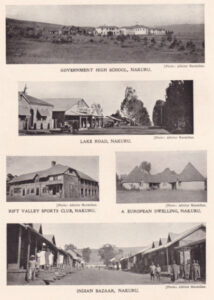Nakuru Township in 1930
Nakuru became a township originally because in 1900 it was a stopping place for the railway on the floor of the Rift Valley after the difficult descent into the valley. How had it fared thirty years after a station was built there just after the turn of the century? Allister Macmillan visited the place in 1929 and this is what he said about it: ‘Nakuru is embowered by trees and consists of one main street named Donald Avenue with various short thoroughfares branching off on each side. The little town is noted for its hospitality and gaiety and its various sports and social clubs, amongst the best institutions of the kind in Kenya. Nakuru has an excellent race course, golf course, and two Masonic lodges, two good hotels, a cinema, and a very fine government school, and a large European Hospital supported by voluntary efforts.
About 200 Europeans lived in and around the town and there was an Asian population of about 600, but the number of Africans has not been recorded. Initially farming around the area was not a success because of what became known as ‘Nakuruitis,’ a disease of animals suffering from a shortage of minerals. Once the cause of the disease was established, appropriate mineral mixtures solved the problem. Apart from the farmers there were several business concerns in the settlement. There were more than three garages, most necessary for the repairs required by vehicles rattled by the corrugated murram roads. A branch of Gailey & Roberts, whose headquarters were in Nairobi, provided a comprehensive stock of agricultural implements, while the nearby Yvonne provided women’s fashions. There was another dressmaker too, Margaret Wallace, assisted by her two sisters Mary and Anne. There was a butcher, photographer, the Crystal Springs Aerated Water Co. and a shop providing books and toys. The largest grocery was run by Harisingh Gujabhai, whose operations began in 1910.
People could stay at two hotels – the Stag’s Head and or the Nakuru Hotel – the former the only one with running hot and cold water. The Nakuru Hotel had been founded by Lord Delamere near the station (the current Midland Hotel is on its site). A large concern was the Nakuru bakery run by Mr and Mrs Albert Speke from a double-storey building with an extensive glass and gun-metal frontage. This included a tearoom with comfortable seats and oak tables, and was a popular rendezvous for the town residents. Behind it was the bakery providing bread and cakes baked by Harriet Speke.
During the war Nakuru racecourse had been a convalescent camp for soldiers and the padre asked Mrs Speke if she would bake some cakes for their canteen. All she had was a No.9 Dover stove, but she managed to provide cakes for 200 men. By the time the camp closed down she was making 2000 cakes a day, so when her husband returned from the war he built her a brick oven and bakehouse on Lake Road. Their three daughters used to push the fresh loaves up to the railway station in the morning before going to school, and that was the origin of Nakuru’s Speke Bakery.

Albert Speke was actually a builder and contractor and had built the Rift Valley Sports Club, most popular in the area. He had started out with his brother in 1912, making bricks by hand from red earth at Rongai, and transporting them by hand cart to Nakuru. He also built the house for Buchan-Sydserff, who insisted that tiles should be cemented to the walls, each of them bearing the imprint of a foot. Some tiles were made with footprints of an ostrich, lion, hippo, rhino, giraffe and Mrs Pike’s tiny newborn baby. Speke’s business flourished as Nakuru expanded into the township it later became.

Recent Comments